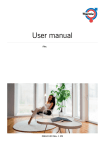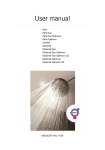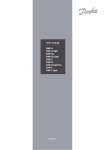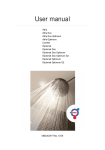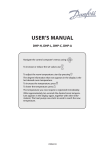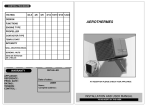Download Danfoss DHP-AQ User manual
Transcript
User manual DHP-AQ VUGFB102 Danfoss A/S reserves the right to make changes to components and specifications without prior notice. © 2010 Danfoss A/S. The Swedish language is used for the original instructions. Other languages are a translation of the original instructions. (Directive 2006/42/EC) Contents 1 Foreword ................................................................................................................................................. 3 2 Safety precautions ................................................................................................................................ 4 3 2.1 Installation and maintenance ............................................................................................................. 4 2.2 System modifications ............................................................................................................................. 5 2.3 Safety valve ................................................................................................................................................ 5 About your heat pump ....................................................................................................................... 6 3.1 4 Control system .................................................................................................................................... 12 4.1 5 6 Components and functions ................................................................................................................. 6 Keypad ...................................................................................................................................................... 12 4.2 Indicator ................................................................................................................................................... 12 4.3 Display ...................................................................................................................................................... 13 4.4 Main Menu ............................................................................................................................................... 15 Settings and adjustments ............................................................................................................... 16 5.1 Setting operating mode ..................................................................................................................... 16 5.2 Adjusting the indoor temperature ................................................................................................. 17 5.3 Distribution circuit 1 and 2 ................................................................................................................ 20 5.4 Hot water ................................................................................................................................................. 20 5.5 Cooling ..................................................................................................................................................... 20 5.6 Reading off temperatures .................................................................................................................. 21 5.7 Reading the operating time .............................................................................................................. 21 5.8 Manual defrost, outdoor unit ........................................................................................................... 21 5.9 Calendar ................................................................................................................................................... 22 5.10 Alarm history ........................................................................................................................................ 23 Regular checks .................................................................................................................................... 24 6.1 Checking operation .............................................................................................................................. 24 6.2 Check the water level in the heating circuit ................................................................................ 25 6.3 Checking safety valves ........................................................................................................................ 25 6.4 In the event of leakage ........................................................................................................................ 26 6.5 Cleaning the strainer for the heating circuit ............................................................................... 26 7 Default setting in the control computer .................................................................................... 28 8 Installation protocol .......................................................................................................................... 29 9 Check list ............................................................................................................................................... 30 10 Service schedule .............................................................................................................................. 32 VUGFB102 – 1 1 Foreword Buying a heat pump from Danfoss is an investment in a better future. A Danfoss heat pump is classed as a renewable energy source, which means that it is considerate of our environment. It is a safe and convenient solution that provides heating, hot water and in certain cases cooling, for your home at a low cost. We thank you for the confidence that you have shown in us by buying a heat pump from Danfoss. We hope that you will benefit from it for many, many years to come. With best wishes Danfoss Heat Pumps User manual VUGFB102 – 3 2 Safety precautions The heat pump cover and control unit cover must only be opened by authorised service technicians. This product is not intended for persons (including children) with reduced physical, sensory or psychological capacity, or who do not have knowledge or experience, unless supervised or they have received instructions on how the apparatus functions from a safety qualified person. Children are not permitted to play with the product. Before changing the control computer’s settings, first find out what these changes mean. Contact your installer for any service work. 2.1 Installation and maintenance DANGER! Only authorized installers may install, operate and carry out maintenance and repair work on the heat pump. DANGER! Only authorised electricians may carry out electrical installations affecting the heat pump. DANGER! Only authorized refrigeration technicians may work on the refrigerant circuit. 4 – User manual VUGFB102 2.2 System modifications Only authorized installers may carry out modifications on the following components: • • • The heat pump unit Water and electrical installations The safety valve Do not carry out construction installations that may affect the operational safety of the heat pump. 2.3 Safety valve The following safety precautions apply to the hot water circuit’s safety valve with corresponding overflow pipe: • • Never block the connection to the safety valve’s overflow pipe. Water expands when it is heated, this means that a small amount of water is released from the system via the overflow pipe. The water that exits the overflow pipe can be hot! Therefore, allow it to flow to a floor drain where there is no risk of burning yourself. User manual VUGFB102 – 5 3 About your heat pump The heat pump is a complete heat pump installation that consists of two basic units: a heat pump placed outdoors and a control unit placed indoors. The control unit is available in three models in order to be able to create as optimal system solution as possible, both in an existing heating system that is to be upgraded and in new builds. Heating and cooling are supplied to the house via a water borne heating system. 3.1 Components and functions 3.1.1 Outdoor unit 3 Pos. Description 2 1 4 6 – User manual VUGFB102 1 Fan 2 Electrical cabinet 3 Air heat exchanger 4 Refrigerant circuit 3.1.2 Control unit 5 3 4 1 DHP-AQ Mini 2 1 3 4 2 1 DHP-AQ Maxi DHP-AQ Midi 3.1.3 Position Description 1 Control module (transparent in image) 2 Immersion heater 3 Reversing valve 4 Circulation pump 5 Water heater Heating The heat pump can produce heat for heating (house, pool) and hot water. The hot water requirement is prioritised before the heating requirement. The heating requirement is calculated from outdoor temperature and set heat curve. An auxiliary heater starts automatically on demand. Heat production is as follows; User manual VUGFB102 – 7 • • • • • A fan draws the outdoor air through an air heat exchanger (1), which heats up the cold refrigerant, which evaporates into a gas. The refrigerant that is now supplied with energy in the form of heat is transferred via the 4 way valve (2) to the compressor (3), where its temperature and pressure are increased. The extremely hot refrigerant continues to the flat heat exchanger (4). Here, the refrigerant is cooled and releases its heat energy to the heating system (5). The refrigerant’s temperature drops and condenses to a liquid state. The heating system transports the heating energy out to the water heater or the heating system of the house. The refrigerant then passes through the drying filter (6) to the electronic expansion valve (7) where the pressure and temperature drop and the process starts again. 5 2 4 6 3 7 1 8 – User manual VUGFB102 3.1.4 Hot water function DHP-AQ Midi and DHP-AQ Maxi are adapted for hot water production. Production of heating and hot water cannot occur at the same time because the reversing valve for heating and hot water is positioned after the heat pump and the immersion heater. Hot water production is prioritised ahead of heat and cooling. DHP-AQ Midi is connected to an existing water heater while DHP-AQ Maxi has an integrated 180 litre heater equipped with a TWS coil (Tap Water Stratificator) which gives more effective heat transfer and efficient layering of water in the heater. The temperature of the hot water cannot be adjusted. Normally, hot water production does not cease at a determined temperature but when the compressor’s operating pressure switch reaches its maximum operating pressure, which corresponds to a hot water temperature of approximately 50-55°C. Using a regular time interval, the water in the water heater is given extra heat by the integrated immersion heater to prevent the build up of bacteria, an anti-legionella function. The factory set time interval is seven days (can be adjusted). 3.1.5 Defrost function During operation the air heat exchanger is cooled by the energy exchange, at the same time the humidity causes it to become covered in frost at low outdoor temperatures. DHP-AQ has an automatic function to defrost the air heat exchanger using the energy from the house's heating system. Defrosting is initiated by low temperature in the refrigerant circuit after the air heat exchanger and, among other things, is dependent on outdoor temperature, humidity and operating time. The length of defrosting varies depending on the extent of freezing of the air heat exchanger. Defrost continues until the air heat exchanger is free of ice and the temperature starts to rise in the refrigerant circuit. After completed defrosting the heat pump returns to the operating mode before defrosting. 3.1.6 Cooling function The heart pump produces cooling through a similar process as the defrosting function. Cooling function is started by the heat pump control unit and is primarily temperature controlled. The house's heating system is cooled by User manual VUGFB102 – 9 transferring heat to the refrigerant circuit, which is then given off in the air heat exchanger. If the hot water heater is installed the control unit will alternate between cooling and hot water production with prioritisation for the hot water requirement. 3.1.7 Speed controlled fan The fan starts at a nominal speed, which differs depending on the size of output. The fan speed is adjusted up or down as required which is determined by the temperatures in the refrigerant circuit. 3.1.8 Electronic expansion valve When the refrigerant passes the expansion valve the pressure and temperature of the refrigerant are reduced. In this way the energy in the outdoor air is available to the refrigerant circuit. By regulating the opening degree of the expansion valve one can optimise the flow in the refrigerant circuit in different operating conditions. Control of the electronic expansion valve is based on the measurements of temperatures and pressures in the refrigerant circuit and outside air. 3.1.9 Auxiliary heat The auxiliary heater is included in DHP-AQ Midi and DHP-AQ Maxi and is available as an accessory for DHP-AQ Mini. An auxiliary heater consists of an immersion heater, which is located on the supply pipe ahead of the reversing valve. If the auxiliary heater is installed it engages AUTO mode automatically when the heat demand is greater than the heat pump’s capacity. Immersion heaters in DHP-AQ series intended for 400V voltage supply have three heating elements (AUX. HEAT 1, 2 and 3) and can be controlled in five power stages. Products for 230V have two heating elements (AUX. HEAT 1 and 2) and are controlled in three power stages. The two stages 4 and 5 cannot be engaged when the compressor is in operation as opposed to stages +4 and +5 where it is possible. 230V 400V Step 1 3 3 Step 2 6 6 Step 3 9 9 Step 4 10 – User manual VUGFB102 12 230V 3.1.10 400V Step 5 15 Step +4 12 Step +5 15 Speed (rpm) control A heat pump requires optimum conditions in the heating system in order to be able to run as efficiently as possible. The temperature difference between the heating system’s supply line and return line must be constant between 7–10°C. If the differences are greater or less, the heat pump is less efficient and savings are lower. The speed controlled circulation pump in DHP-AQ always ensures that the temperature difference is retained. The control equipment detects if the balance is upset and increases or decreases the speed of the circulation pump as necessary. User manual VUGFB102 – 11 4 Control system The heat pump has an integrated control system which automatically calculates the heating and cooling demand in the house to ensure that the correct amount of heating and cooling is produced and emitted where necessary. The control panel is operated using a keypad and information is shown in a display and by an indicator. The information in the display and menus will vary depending on the menu selection made and connected accessories. ROOM 20°C NO HEAT DEMAND 3 OPERAT. AUTO 1. 2. 3. Keypad Indicator Display 1 2 4.1 Keypad + Plus sign used to scroll up a menu and increase the values. - Minus sign used to scroll down a menu and reduce the values. > Right arrow used to select a value or open a menu. < Left arrow to cancel selection or exit a menu. 4.2 Indicator The indicator at the bottom of the control panel has three modes: 12 – User manual VUGFB102 • • • 4.3 Not lit, means that the heat pump is not powered. When the green light shines continuously, the heat pump has power and is ready to produce heat, cooling or hot water. Flashing green, means an active alarm. Display The display shows information about the heat pump’s operation, status and any alarms. Table 1. Symbols shown in the display. Symbol F Meaning COMPRESSOR Indicates that the compressor is in operation. LIGHTNING Indicates that the auxiliary heater is in operation. The number indicates what additional step is activated. HOUSE Indicates that the heat pump produces heat for the heating system. TAP Indicates that the heat pump produces heat for the water heater. FLOW SENSOR Indicates that the flow sensor is active (there is flow). CLOCK Indicates that tariff control is active. TANK Indicates the level of hot water in the water heater. When hot water is produced for the water heater, this is indicated by a flashing icon for the tank. A lightning symbol by the symbol indicates peak heating charging (anti-legionella function). SQUARE Either indicates that the operating pressure switch has deployed, or that the pressure pipe temperature has reached its maximum temperature. DEFROST Displayed when defrosting is active. User manual VUGFB102 – 13 Symbol Meaning FAN Displayed when the fan is active. COOLING Displayed if cooling is produced. A = Active cooling. The following operating information may also appear: Message Meaning ROOM Shows the set ROOM value. Standard value: 20°C. If the accessory room sensor is installed it shows the actual temperature and the desired indoor temperature is shown within brackets. START Indicates that there is a need for heat production or hot water and that the heat pump will start. EVU STOP Indicates that the additional function EVU is active. EVU is used to switch off the heat pump during high energy tariffs. NO HEAT DEMAND Indicates that there is no heating or hot water production demand. NO COOLING DEMAND Indicates that there is no cooling demand. COMPRESSOR START Indicates that there is a need for heat, hot water or cool--XX ing and that the heat pump will start in XX minutes. COMPRESSOR +IMM.HEAT Indicates that heat production is active with both compressor and auxiliary heater. START_MIN Indicates that there is a demand for heating or hot water production but that a start delay is active. AUX. HEATER Indicates that there is an auxiliary heater demand. ACT COOLING Displayed if cooling is active. DEFROST X(Y) Displayed when defrosting is active. X shows the actual reached temperature. Y shows at what temperature defrost is complete. 14 – User manual VUGFB102 4.4 Main Menu The display's INFORMATION menu is used to set and adjust the heat pump functions and is opened by pressing the left or right buttons. The appearance of the menu will vary depending on the menu selection made and connected accessories. The basic menu appears as follows: 2 3 4 INFORMATION OPERAT. HEATING HOT WATER DEFROST CALENDAR 1 1. 2. 3. 4. Sub-menus Return Cursor If an arrow is shown, it indicates that more sub menus are continued underneath Press the + and - buttons to move the cursor between the sub-menus. Press the right button to select a sub-menu. Press the left button to go back in the menu. User manual VUGFB102 – 15 5 Settings and adjustments The installer carries out the basic settings of the heat pump at installation. A number of settings and adjustments that you can carry out yourself are described below. Before changing the control computer’s settings, first find out what these changes mean. Make a note of the default setting. 5.1 Setting operating mode OPERAT. 1. AUTO COMPRESSOR AUX. HEATER HOT WATER MANUAL TEST 2. 3. 4. Open the menu OPERAT. in the INSTALLATION menu. The asterisk shows the current selection Mark new mode using + or – button. Press the right button once to confirm the choice. Press the left button twice. The following operating modes can be selected: Operating mode (OFF) Meaning The installation is fully switched off. This mode is also used to acknowledge certain alarms. AUTO The heat pump regulates automatic compressor operation and auxiliary heater. COMPRESSOR The control system is controlled so that only the heat pump unit (compressor) is allowed to operate. In this operating mode peak heating charging (anti-legionella function) of the hot water will not run because the auxiliary heater is not used. AUX. HEATER The control system only permits the auxiliary heater to be in operation. 16 – User manual VUGFB102 Operating mode Meaning HOT WATER In this mode the heat pump only produces hot water, no heat goes to the heating system. MANUAL TEST Only displayed when the value for MANUAL TEST is set to 2 in The SERVICE menu. Outputs that control components are activated manually. Caution! If the operating mode OFF or HOT WATER is to be used for long periods during the winter, the water in the heating system in the heating system must be drained, otherwise there is a risk of frost damage. Alternatively the system solution with intermediate exchanger should be used. 5.2 Adjusting the indoor temperature The indoor temperature is adjusted by changing the heat pump’s heat curve, which is the control system’s tool for calculating the heating demand, the integral value. The integral value is determined by comparing the actual temperature of the heating system's supply line with the calculated value, the setpoint value. The heating requirement is calculated from the current outdoor temperature and heat curve setting. The heat curve will be adjusted in connection with installation. It must be adapted later on, however, to obtain a pleasant indoor temperature in any weather conditions. A correctly set heat curve reduces maintenance and gives energy efficient operation. There are two ways of adjusting the heat curve, partly in the HEATING sub-menu, partly with the ROOM value. Adjusting CURVE A typical heat curve is shown below. When the outdoor temperature is 0°C the heat pump control tries to make the temperature in the supply line 40°C. At hotter or colder outdoor temperatures than 0°C the set User manual VUGFB102 – 17 point that the control regulates against is lowered or raised respectively. When you increase the CURVE value, the heat curve will become steeper and when you reduce it, it will become flatter. This is the most energy and cost efficient way to set the indoor temperature and should therefore be used for long term temperature settings. 1 56 2 5 40 24 1. 2. 3. 4. 5. Supply temperature (°C) Maximum setpoint value Outdoor temperature (°C) 0°C Set value (standard 40°C) 3 20 0 -2 0 4 The following parameters can be adjusted in the HEATING menu: Parameter Description CURVE If the CURVE value is increased, the heat curve will become steeper and if the value is reduced, it will become flatter. Raise or lower as necessary to obtain as even an indoor temperature as possible. MIN Lowest set point for supply temperature. MAX Highest set point for supply temperature. CURVE 5 Used to adjust the heat curve at an outdoor temperature of +5°C. CURVE 0 Used to adjust the heat curve at an outdoor temperature of 0°C CURVE -5 Used to adjust the heat curve at an outdoor temperature of -5°C. 18 – User manual VUGFB102 Parameter Description HEAT STOP This function stops all production of heat when the outdoor temperature is equal to, or higher than, the set heat stop value. SETBACK TEMP The temperature that will apply at temperature setback controlled from the CALENDAR menu. High temperatures in an underfloor heating system can damage parquet floors. Adjust the heat curve in the HEATING sub-menu as follows: HEATING CURVE MIN MAX CURVE +5 CURVE 0 CURVE -5 HEAT STOP 40˚C 10˚C 55˚C 0˚C 0˚C 0˚C 17˚C 1. 2. 3. 4. 5. Open the HEATING sub-menu in the INFORMATION menu Mark desired parameter using + or – button. Open the parameter by pressing the right button once. Raise or reduce the value with the + or button. Press the left button three times. Adjusting ROOM values The heat curve and therefore the indoor temperature can be affected by changing the "ROOM" value. If the ROOM value is used to affect the system’s heat curve, the heat curve does not become steeper or flatter, which the curve becomes if the CURVE value changes, instead the entire heat curve is moved by 3°C for every degree change of the ROOM value. Note! For a temporary increase or reduction of the indoor temperature, adjust the ROOM value instead. Change the ROOM value as follows: User manual VUGFB102 – 19 1. 2. 3. 5.3 Press either the + or - button once to open and change the ROOM value. Raise or reduce the ROOM value using the + or - buttons to change the indoor temperature. Wait ten seconds or press the left button once to exit the menu. Distribution circuit 1 and 2 In addition to the main circuit for heating and cooling two distribution circuits can be controlled individually. The same parameters are used for these as in the main circuit (menu HEATING). 5.4 Hot water HOT WATER HOT WATER TOP-UP ON HOT WATER is used to control hot water production. By activating TOPUP the heat pump can immediately start to heat the water heater using the compressor and electrical auxiliary heater until the tank is fully heated. 5.5 Cooling COOLING ON COOLING 25˚C START 16˚C STOP COOLINGMODE ACTIVE 25˚C COOLING is used to control cooling. START and STOP control the cooling system's temperature range. COOLINGMODE ACTIVE gives the lowest outdoor temperature that cooling production is permitted at. Low temperatures can cause condensation. 20 – User manual VUGFB102 5.6 Reading off temperatures OP. DATA OUTDOOR 0˚C ROOM 20˚C SUPPLY LINE 38(40)˚C RETURN LINE 34(55)˚C SYSTEM SUPPLY 35(40)˚C DISTR. CIRC. 1 32(35)˚C DISTR. CIRC. 2 28(30)˚C The set point value for the supply line and the max value of the return line is shown within brackets The max value indicates the temperature at which the compressor is stopped. No values can be changed in this menu. The different temperatures that the installation has are shown here. All temperatures are stored back in time so that they can also be displayed in the form of graphs. If ROOM shows 20°C the heat curve is unaffected. If ROOM shows higher or lower, this indicates that the heat curve has been adjusted up or down. 5.7 Reading the operating time OPERAT. TIME COMPRESSOR COMPRESSOR SL HEATING COOLING HOT WATER AUX. HEAT 1 AUX. HEAT 2 AUX. HEAT 3 EXT.AUX.HEATER OH OH OH OH OH OH OH OH OH COMPRESSOR shows the total time in hours that the heat pump has been in operation since installation. AUX. HEAT 1, 2 and 3 refer to the immersion heater and its different power stages. 5.8 Manual defrost, outdoor unit If the heat pump requires defrosting you can run a defrosting procedure manually from the control computer. To defrost manually: User manual VUGFB102 – 21 1. 2. 3. 4. 5. 6. 7. 5.9 Press either the right or left button once to open the INFORMATION menu. The cursor is in the OPERATION menu option. Press the down button to move the cursor to the DEFROST menu option. Open the menu by pressing the right button once. Press the down button to move the cursor to the MANUAL DEFROST menu option. Press the right button once. Press the up button once to start defrost. Press the left button three times to exit the menu. Calendar The following functions can be controlled via calendar: • • • • Blocking hot water production Stopping the heat pump at high energy tariff (EVU) Reducing the noise of the fan (gives reduced performance) Reducing the temperature in the heating and distribution circuits. Do as follows; 1. Select which function is to be controlled 2. Select a CALENDAR SETTING (up to 8 can be selected for each function) 3. Select the menu TIME FUNCTION if the function should be over a continuous time period (DATE) or be recurring (DAYS / WEEK). 4. Select start and stop times and date and weekdays in the TIME SETTING menu. Examples of a recurring calendar control (DAYS / WEEK) TIME SETTING START STOP MONDAY TUESDAY WEDNESDAY THURSDAY FRIDAY 12:00 14:30 * * * 22 – User manual VUGFB102 5.10 Alarm history NAME ALARM displays information about up to 10 alarms with type of alarm, time and date. User manual VUGFB102 – 23 6 Regular checks 6.1 Checking operation During normal operation, the alarm indicator lights green continuously to show that everything is OK. When the alarm is triggered, it flashes green at the same time as a text message is shown in the display. ALARM LOW PRESSURE ERROR Regularly check the alarm indicator to ensure that the installation is working correctly. In event of alarm the heat pump will if possible supply heating to the house, primarily with the compressor, secondarily with the auxiliary heater. Hot water will stop to indicate that something noteworthy has occurred. In event of alarm this is indicated in the display with the text ALARM and an alarm message. The potential alarm messages are: Message Meaning HIGH PRESSURE ERROR The heating circuit is the heat pump's high pressure circuit. Check, and, if necessary, rectify the circuit level as below. Reset the alarm as follows LOW PRESSURE ERROR The brine circuit is the heat pump's low pressure circuit. Contact the service technician. 24 – User manual VUGFB102 Message Meaning ERR PHASE SEQ. Can be displayed in conjunction with interference in the mains network, for example after a temporary power cut. Reset the alarm as follows. If necessary switch off the power supply for a minute or two. Other alarm message Reset the alarm as follows. If the alarm remains contact a service technician. Resetting the alarm For alarms that are not reset automatically acknowledgement is required. Acknowledge the alarm by setting the heat pump to operating mode OFF and then back to the desired operating mode. 6.2 Check the water level in the heating circuit The line pressure of the installation must be checked once a month. The external manometer must show a value between 1-1.5 bar. If the value is below 0.8 bar, when the water in the heating system is cold, the water must be topped up (applies in the event of an empty expansion tank). You can use normal tap water when topping up the heating system. In certain exceptional cases the water quality may be so poor (for example very hard water) that it is not suitable for filling the heating system. If unsure, contact your installer. Note! Do not use any additives for water treatment in the heating system’s water! Note! The closed expansion tank contains an air filled bladder that absorbs variations in the heating system’s volume. Under no circumstances may it be drained of air. 6.3 Checking safety valves Both the safety valves for the installation must be checked at least four times a year to prevent lime deposits clogging the mechanism. The safety valve of the water tank protects the enclosed heater against over pressure in the water tank. It is mounted on the cold water inlet User manual VUGFB102 – 25 line, its outlet opening facing downwards. If the safety valve is not checked regularly, the water tank might be damaged. It is quite normal that the safety valve lets out small amounts of water when the water tank is being charged, especially if a lot of hot water was used previously. Both safety valves can be checked by turning the cap a quarter of a turn clockwise until the valve lets out some water through the overflow pipe. If a safety valve does not work properly, it must be replaced. Contact your installer. The opening pressure of the safety valves is not adjustable. 6.4 In the event of leakage In the event of leakage in the hot water pipes between the heat pump and water taps, close the shut-off valve on the cold water inlet immediately. Then contact your installer. 6.5 Cleaning the strainer for the heating circuit The heat pump must be switched off at the main switch before cleaning can be started. The strainer must be cleaned twice a year after installation. The interval can be extended if there is evidence that cleaning twice a year is not necessary. Have a cloth to hand when opening the strainer cover as a small amount of water usually escapes. 1 3 4 2 Clean the strainer as follows: 26 – User manual VUGFB102 1. 2. 3. 4. Stopcock Cover Strainer O-ring 1. 2. 3. 4. 5. 6. 7. 8. 9. 10. Switch off the heat pump. Turn the stopcock to the closed position (see figure above). Unscrew the cover and remove it. Remove the strainer. Rinse the strainer. Reinstall the strainer. Check that the o-ring on the cover is not damaged. Screw the cover back into place. Turn the stopcock to the open position. Start the heat pump. User manual VUGFB102 – 27 7 Default setting in the control computer The first column in the table below shows the parameters that can be adjusted by the User. The second column shows settings made at the factory, and the third column the settings made by the installation contractor in connection with installation of the heat pump. Setting Factory setting ROOM 20°C OPERAT. AUTO CURVE 40°C MIN 10°C MAX 55°C (45°C for under floor heating) CURVE 5 0°C CURVE 0 0°C CURVE -5 0°C HEAT STOP 17°C 28 – User manual VUGFB102 Any customer specific settings 8 Installation protocol Heat pump model ............................................................... Serial number ............................................................... Type of collector ............................................................... Volume of brine (litres) ............................................................... Pipe installation – Company ............................................................... - Contact person ............................................................... - Telephone number ............................................................... Electrical installation – Company ............................................................... - Contact person ............................................................... - Telephone number ............................................................... Commissioning – Company ............................................................... - Contact person ............................................................... - Telephone number ............................................................... - Date final inspection ............................................................... User manual VUGFB102 – 29 9 Check list Positioning □ Surface adjustment □ Drainage Pipe installation, hot and cold side □ Pipe connections in accordance with the diagram □ Flexible hoses □ Expansion and bleed tank □ Strainer, hot and cold side □ Pipe insulation □ Open radiator valves □ Leak test, hot and cold side Electrical Installation □ Circuit-breaker □ Fuse □ Positioning of the outdoor sensor Commissioning □ Bleeding, hot and cold side □ Settings control system □ Manual test components □ Manual test different operating conditions □ Noise check □ Function test safety valve □ Function test mixer valve □ Trimming the heating system Customer information □ Contents of this manual 30 – User manual VUGFB102 □ Safety precautions □ Control computer, function □ Settings and adjustments □ Regular checks □ Reference to service requirement □ Warranties and insurances User manual VUGFB102 – 31 10 Service schedule To achieve best performance and service life we recommend Danfoss that the heat pump is serviced at 12 month intervals. Service company* Service technician's signature* Date (year-month-day)* Customer's signature* Comments* Service company* Service technician's signature* Date (year-month-day)* Customer's signature* Comments* Service company* Service technician's signature* Date (year-month-day)* Customer's signature* Comments* Service company* Service technician's signature* Date (year-month-day)* Customer's signature* Comments* Service company* Service technician's signature* Date (year-month-day)* Customer's signature* Comments* 32 – User manual VUGFB102 VUGFB102



































